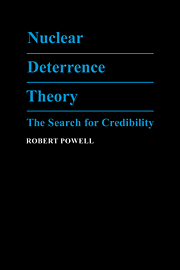Book contents
- Frontmatter
- Contents
- Preface
- 1 Introduction
- 2 The nuclear revolution and the problem of credibility
- 3 The dynamics of nuclear brinkmanship
- 4 Stability and longer brinkmanship crises
- 5 Crisis stability in the nuclear age
- 6 Stability and the lack of control
- 7 The strategy of limited retaliation
- 8 An appraisal
- Appendix Some introductory notes on game theory
- References
- Index
Appendix - Some introductory notes on game theory
Published online by Cambridge University Press: 13 October 2009
- Frontmatter
- Contents
- Preface
- 1 Introduction
- 2 The nuclear revolution and the problem of credibility
- 3 The dynamics of nuclear brinkmanship
- 4 Stability and longer brinkmanship crises
- 5 Crisis stability in the nuclear age
- 6 Stability and the lack of control
- 7 The strategy of limited retaliation
- 8 An appraisal
- Appendix Some introductory notes on game theory
- References
- Index
Summary
The mathematical analysis in the preceding chapters, for the most part, involves nothing more than algebra. The analysis does, however, appeal to a game-theoretic vocabulary and set of concepts that may be unfamiliar. This Appendix introduces those concepts and vocabulary in order to give readers with little or no background in game theory a better sense of the tools used to analyze deterrence theory and some of the strengths and weaknesses of those tools.
The extensive form.
The brinkmanship and limited-retaliation models are examples of games in extensive form. A game in extensive form is composed of two parts. The first is the game form or game tree. The second is the players’ payoffs. The game form or tree is an abstract summary of the situation facing the players. The tree tells the order of play, the set of alternatives from which each player must choose when it plays, and what each player knows when it must choose. The tree defines who moves after whom, what each player can do, and what each player knows about what the other players have done when it must decide what to do.
Two very simple trees are illustrated in Figure A1. In both Figure A1(a) and A1(b) the order of play is the same. Player I moves first, and then player II moves.
Information
- Type
- Chapter
- Information
- Nuclear Deterrence TheoryThe Search for Credibility, pp. 187 - 220Publisher: Cambridge University PressPrint publication year: 1990
